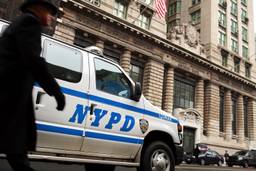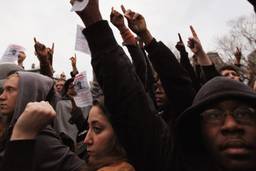One of Occupy’s biggest advantages is its ability to be highly disruptive with minimal resources. Armed with nothing more than cell phones, leaflets, and in some cases, only a dozen other activists, Occupiers are able to shut down —or at the very least, cause lots of chaos— at places like Times Square, Rockefeller Center, and Grand Central Station.
In the case of Occupy Oakland, such a strategy was applied this week at city hall:
Oakland City Hall was shut down Thursday afternoon, after two dozen Occupy Oakland protesters tried to storm the building.
Members of Occupy Oakland’s interfaith coalition called for protesters to take over the mayor’s and city administrator’s offices Thursday after police arrested 12 protesters in Frank Ogawa Plaza on Wednesday night.
The protesters arrested Wednesday were violating the terms of a permit, according to city officials.
Police Chief Howard Jordan revoked the permit Monday because Occupiers were sleeping in and around the teepee, cooking and serving food there and using the area for storage.
CBS has video footage of police in riot gear advancing on the camp just before midnight on Wednesday in order to dismantle the encampment.
Police arrested a dozen Occupiers for the usual excuse of camping without a permit, but also the crime of distributing food sans a permit and setting up trash cans.
In response to the police action, activists gathered at Frank Ogawa Plaza on Thursday afternoon before splitting up and trying to enter city hall through the side doors on opposite sides of the building, CBS reports.
They banged on the doors on the 14th Street side, and demanded to be let in. A man came to the door and told the protesters that someone would come out and talk to them, but that they had to “calm down.”
The protesters then tried to push their way through the doors but were blocked and the doors locked again.
The excuse given for shutting out the protesters came from police Sgt. Serge Babka, who said, “We cannot accommodate a large group, so we had to close the doors.”
The timeline of events here is very important. Certain media outlets are using phrasing that Occupiers “stormed” city hall, but independent journalist Susie Cagle reports that it was only after the doors were locked that the protest turned angry.
“Doors locked, then OPD opened & ppl told not allowed, then chants & anger,” Cagle tweeted.
Finally, around 2:30 p.m., officers allowed four members of the Interfaith Council to enter the building and talk to city staffers.
Ingrid Martin, a landscape designer who had hoped to see Quan, said, “We want to talk to them about our rights being violated, our right to assemble, protest and free speech. Why is it OK for them to repress our First Amendment rights?”
Jeremy Nickel, another protester, said, “The image of a locked City Hall speaks for itself.”
Rachel Dorney, 23, said Wednesday night’s arrests were part of a harassment campaign by police.
“They want people to get tired,” Dorney said. “They want people to stop showing up. But we can’t show the police they’re winning.”
The city hall action is part of a tradition of protest in Oakland stemming from Nov. 29 when police dismantled Occupy Oakland’s camp in Frank Ogawa Plaza and other sister sites.




